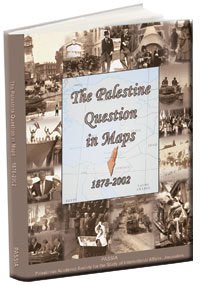The Palestine Question in Maps, 1878-2002
Including over 50 color maps, this publication provides a guide to the
Palestine Question from the Ottoman period through to 2002, shedding
light on the real territorial dimensions of the conflict, its causes, and the numerous schemes posited over time for its resolution. A first series of maps
follows the path of modern Palestinian history in chronological order, focusing
on key demographic themes and political milestones, as well as identifying the
various proposals posited for the resolution of the Palestine Question (Chapters
1-3). Jerusalem itself is of such intrinsic importance to Palestinian history and
to the resolution of the Palestine-Israel conflict, that a separate section is
devoted, in detail, to its changing circumstances (Chapter 4). Core issues, such
as water and refugees, are also addressed in a separate chapter (Chapter 5).
The text accompanying the maps presents a concise and clear overview of the
historical, political and socio-economic circumstances providing the back drop
for the individual maps and illustrating their place within the broader frame
of Palestinian history. Complete with statistics, detailed references and notes,
the text serves to illuminate the factors defining the territorial dimensions
portrayed within the maps.
Overview
The accurate and responsible presentation of the Palestine Question, both in its current context and throughout the course of history, has long been a chief goal of PASSIA. With an extensive catalogue of in-depth works on crucial aspects and periods of Palestinian history to its name, PASSIA has also sought to create suitably concise publications presenting the core issues and the Palestinian narrative in a comprehensive, yet comprehensible format. The Palestine Question in Maps, 1878-2002, represented an important addition to this aspect of PASSIA’s work.
Passia is proud to be able to say that this book became a viable reference for researchers, scholars and students. However, while still on high demand the book has been out of print for several years now and required updating. The PASSIA team took on this task - adding maps and background information on maps that evolved over the past decade (i.e., covering the period since 2002) – and is now proud to present a second edition of The Palestine Question in Maps, this time covering the period from 1878 to 2014.
Including over 70 color maps, this research study is hoped to provide a guide to the Palestine Question from the Ottoman period through to the present day. In addressing the unfolding geographic and demographic complexities of the period in review, the book sheds light on the real territorial dimensions of the Palestinian-Israeli conflict, its causes, and the numerous schemes posited over time for shaping a resolution and an accepted end to the conflict. Dissemination and explanation of clear and reliable maps has always been rare and a frequently baffling array of speculations has all too often led to confusion rather than comprehension, both abroad and in Palestinian society. By compiling and reviewing the most important historical and contemporary maps, this book offers researchers, readers and concerned individuals the opportunity to understand the geographic implications and political motivations guiding the political and military aspects of the Palestine Question for over a hundred years.
A first series of maps follows the path of modern Palestinian history in chronological order, focusing on key demographic themes and political milestones, as well as identifying the various proposals posited for the resolution of the Palestine Question (Chapters 1-4). Jerusalem itself is of such intrinsic importance to Palestinian history and to the resolution of the Palestine-Israel conflict, that a separate section is devoted, in detail, to its changing circumstances (Chapter 5). Core issues, such as water and refugees, are also addressed within a separate chapter (Chapter 6).
The text accompanying the maps is hoped to present a concise and clear overview of the historical, political and socio-economic circumstances providing the backdrop for the individual maps and illustrating their place within the broader frame of Palestinian history. Complete with reliable statistics, detailed references and notes, the text serves to illuminate the factors defining the territorial dimensions portrayed within the maps.
At its most fundamental level, the Palestine Question is a question of a land and its people, as well as their rights, identity and passage through time. For this reason, placing an accurate account of Palestinian history squarely within its territorial dimensions is not only advantageous for those seeking a deeper understanding of that history, but is an important step in repossessing a history that has so often been distorted, denied and dislocated from its rightful context and placed within alien and imposed schemes so as to confuse, deny, and replace that history for the purposes of another.
As a part of PASSIA’s ongoing documentation of Palestinian history, this work is intended to present the history of the Palestine Question in a responsible, accessible and compelling way so that it may be easily understood by readers today and properly preserved for future generations.
Dr. Mahdi Abdul Hadi
Chairman of PASSIA - Jerusalem

